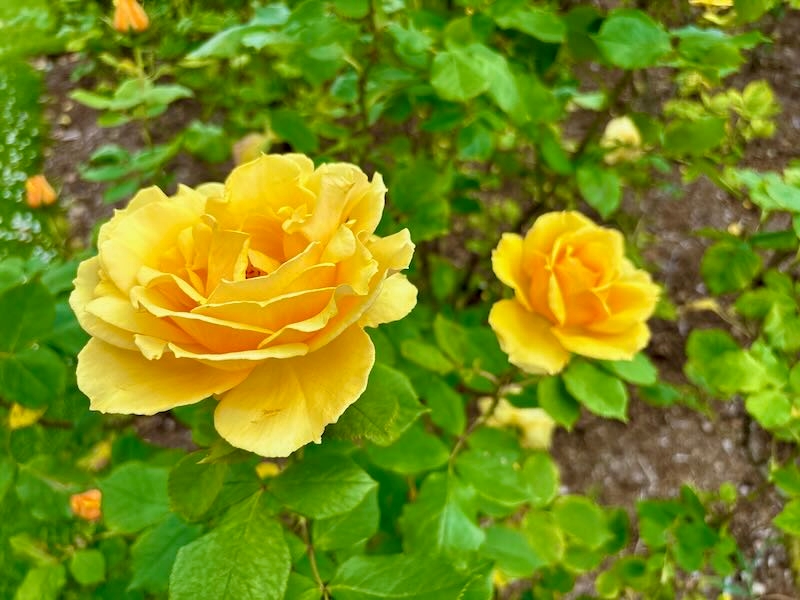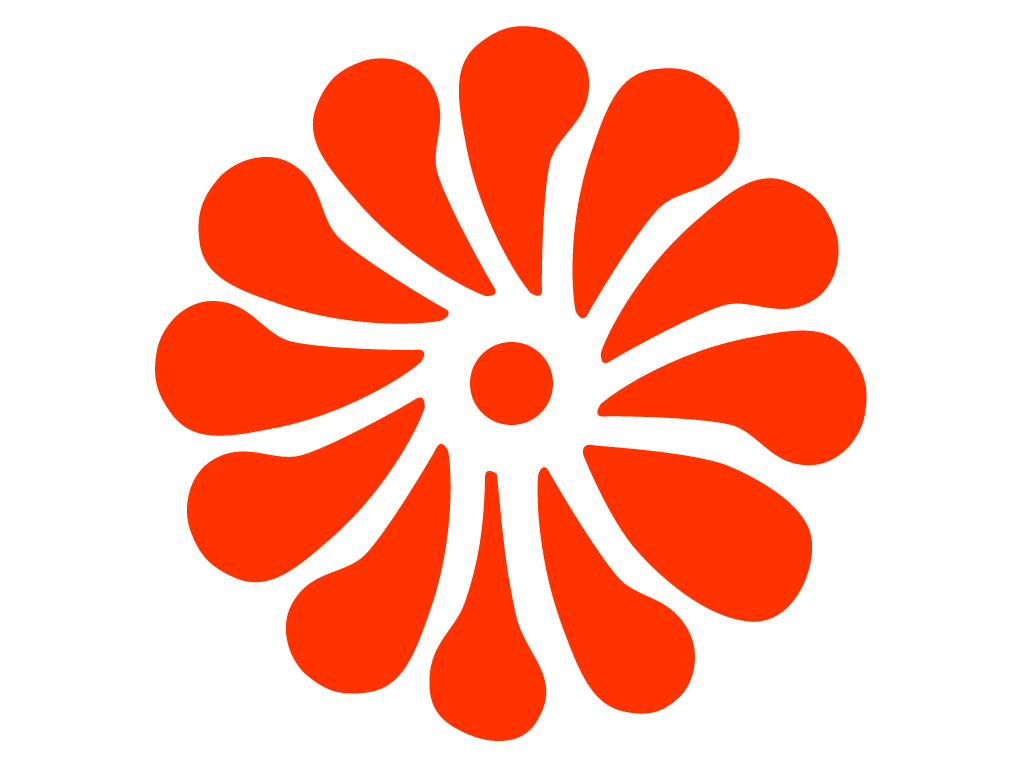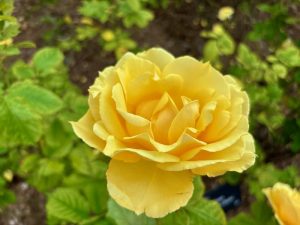Cream & Spice In The Border: Grow Rosa ‘Southern Belle’ For Elegant, Repeat Blooms
Rosa ‘Southern Belle’ brings soft, creamy blooms with a hint of buttery buff to beds, borders, and cutting gardens. This Grandiflora rose produces full, cupped flowers with 35–45 petals and a sweet, spicy fragrance. Clusters open from rounded buds and hold their form on long, sturdy stems. Belonging to the Rosaceae family, Rosa ‘Southern Belle’ keeps an upright, bushy habit and reblooms from late spring to fall. Gardeners know it as Southern Belle Rose or Grandiflora ‘Southern Belle’, and you will often see it recommended for mixed borders and vase work because the stems cut cleanly and last well indoors.
Meet Rosa ‘Southern Belle’ (Southern Belle Rose)
This Grandiflora marries the large, high-centered look of Hybrid Teas with the cluster performance of Floribundas. Expect plants 1.2–1.5 m tall (4–5 ft) and about 0.9–1.2 m wide (3–4 ft) when mature. The foliage stays dark, glossy green and sets a polished backdrop for flowers that average 10–12 cm across (4–5 in). Buds start a pale cream and open to white or ivory with a light buff glow near the center. Because blooms come in waves, you get several strong flushes rather than a single peak.
A quick note on names
Nurseries sometimes label this plant as Southern Belle Grandiflora Rose or simply Southern Belle Rose. Do not confuse it with Southern Belle Hibiscus, which is a hardy Hibiscus group. If a tag mentions enormous dinner-plate blooms, that plant is the hibiscus. If the tag promises fragrant, cupped roses on thorny canes, you have the right one.
Choose this rose for three clear reasons. First, it offers reliable rebloom and fragrance on a tidy shrub. Second, it mixes easily with many palettes. Cream and buff partner with lavender, blue, coral, and burgundy without a clash. Third, it produces long, straight stems that shine in arrangements. Because the blooms hold color in heat and cool, you can plan for bouquets from May to frost in many climates.
Growth habit, size, and site fit
Rosa ‘Southern Belle’ grows upright and bushy with good basal breaks when pruned well. New shoots push from low on the plant and keep the frame young. The shrub slots into the middle of a border and reaches window-view height in a season or two. Space it 75–90 cm apart (30–36 in) in hedges for an even line. In large beds give it 90–120 cm (36–48 in) from neighbors to ensure airflow and light reach.
Flowering season and performance
Bloom begins in late spring once nights sit above 10 °C (50 °F). The first flush often carries the largest blossoms. After deadheading, the plant rests a few weeks, then fires a second wave. In warm regions with steady care, a third and even fourth flush can follow. Cooler nights deepen the center tint and sharpen the perfume, so autumn flowers often look and smell the best.
The scent leans sweet with spice and a touch of classic rose. Because petals pack tightly, fully open flowers read lush but not heavy. Cut when outer petals unfurl and the center remains cupped. In clean water with a floral preservative, stems hold five to seven days. Recut stems after conditioning to extend vase life.
Hardiness and climate
Grow Rosa ‘Southern Belle’ in USDA Zones 6–9 for best performance. In Zone 6 it appreciates winter protection. In hot-summer zones, provide afternoon shade to preserve petal edges during heat spikes. The plant tolerates brief heat above 32 °C (90 °F) if roots stay cool and watered. It dislikes prolonged drought and waterlogged soil alike.
Design ideas with Southern Belle Rose
Use Southern Belle Rose to soften strong plant shapes. It pairs well with blue Salvia, Nepeta, Catmint, Lavender, and Russian Sage. Cool tones make the creamy petals glow. For warm schemes, mix with Apricot Foxgloves, Peach Daylilies, and Bronze Carex. In formal beds, repeat three shrubs at even intervals and low-hedge the line with boxwood for a classic look. In cottage borders, weave it between perennials and let airy companions thread through the canes.
Soil, pH, and mulch basics
Roses need moisture and oxygen at the same time. Aim for rich, well-drained loam at pH 6.0–7.0. Blend 5–8 cm (2–3 in) of compost into the top 20–25 cm (8–10 in) at planting. After establishment, maintain a 5–7 cm (2–3 in) mulch of shredded bark or leaf mold to steady soil temperature and reduce evaporation. Pull mulch a few centimeters back from the crown to prevent rot.
Fertility and water needs at a glance
Feed lightly but consistently. Use a balanced, slow-release rose fertilizer in spring as buds swell, then again after the first flush. Where summers run long, a light, mid-season potassium boost supports flower quality. Provide roughly 2.5–4 L (0.7–1 gal) of water per plant two to three times weekly in hot, dry spells, adjusting for rain and soil type. Always water at the base early in the day.
Container culture
You can grow Rosa ‘Southern Belle’ in a large pot if you water and feed on schedule. Choose a container at least 45–50 cm wide (18–20 in) with large drainage holes. Use a high-quality potting mix that drains fast but holds moisture. Set the pot where it receives six or more hours of sun. Rotate monthly to keep growth even, and top-dress with compost in spring.
How to Grow Rosa ‘Southern Belle’
Use the steps below to set the shrub up for seasons of flowers. The H4 sections make it easy to skim.
Light
Give full sun for best bloom. Aim for at least six hours daily. In hot inland summers, morning sun plus light afternoon shade protects petals. Too much shade reduces flowers and invites disease, so move nearby shrubs or thin branches if the rose sits in deep shade.
Soil
Plant in fertile, well-drained soil. Work in compost and coarse sand or fine grit if you garden on heavy clay. In very sandy sites, increase organic matter to improve water-holding. Target pH between 6.0 and 7.0. Test soil every few years and adjust with sulfur or lime as needed.
Watering
Water deeply and regularly. During the first year, keep the root zone evenly moist, not soggy. As a guide, apply 10–15 L (2.5–4 gal) per plant weekly during dry weather. In established shrubs, water when the top 5–7 cm (2–3 in) of soil dries. Use a soaker hose or drip line to keep foliage dry and reduce black spot risk.
Fertilizing
Feed in a steady, moderate way. In early spring, apply a slow-release, balanced rose fertilizer at label rates. After the first flush, feed again to support rebloom. In late summer, switch to a lower-nitrogen, higher-potassium feed to strengthen canes. Stop fertilizing six to eight weeks before your average first frost to avoid tender late growth.
Mulching
Mulch 5–7 cm deep (2–3 in) with shredded bark, leaf mold, or compost. Mulch suppresses weeds, saves water, and protects roots from heat. Keep mulch 5 cm (2 in) away from canes to prevent crown rot and vole damage.
Planting & Spacing
Plant bare-root roses in early spring as soil thaws. Plant container roses in spring or fall. Dig a hole twice as wide as the root system and just as deep. In cold winter regions, set the bud union 2–5 cm (1–2 in) below soil level. In mild climates, keep it at or slightly above grade. Backfill with native soil amended with compost. Water to settle. Space shrubs 90–120 cm (36–48 in) from neighbors for airflow.
Pruning & Deadheading
Prune in late winter or very early spring as buds swell. First remove dead, damaged, or crossing wood. Then reduce remaining canes by one-third to one-half, cutting to outward-facing buds at a 45-degree angle. Through the season, deadhead spent clusters to the first strong five-leaflet leaf. This step triggers new flowering shoots. In late fall, shorten very tall canes by one-third in windy sites to prevent rocking.
Temperature & Overwintering
In Zones 6–7, mound 15–20 cm (6–8 in) of composted bark over the crown after the first freeze. And, in Zones 8–9, winter care is lighter: clean up leaves and refresh mulch. In all zones, water well before the ground freezes so roots enter winter hydrated. In early spring, pull back protective mounds as growth begins.
Staking & Support
Most plants stand well on their own. However, very windy sites can whip long canes. If needed, insert discreet stakes and tie canes loosely with soft ties in late fall. Remove ties in spring after pruning.
Container Water & Feed
Potted roses dry faster. In summer heat, plan to water daily or every other day, applying until water flows from the base. Feed containers every four to six weeks with a balanced liquid fertilizer at half strength, or use a controlled-release product at label rates.
Rosa ‘Southern Belle’ Propagation
Home gardeners can propagate from semi-hardwood cuttings in midsummer. Take 10–15 cm (4–6 in) cuttings from healthy, non-flowering shoots. Remove lower leaves and dip the base in rooting hormone. Insert into a sterile, free-draining mix of perlite and peat-free compost. Keep humidity high under a clear dome and hold temperature near 21–24 °C (70–75 °F). Roots form in four to eight weeks. Budding or grafting onto vigorous rootstocks is another path used by nurseries. For reliable, named plants, buy from reputable growers.
Rosa ‘Southern Belle’ Pests & Diseases
Good culture prevents most issues. Still, scout weekly so you can act early.
Aphids colonize tender tips in spring. Spray off with a firm stream of water, then follow with insecticidal soap if needed. Spider mites flare in hot, dry weather; raise humidity around the plant, rinse leaf undersides, and use a labeled miticide if infestations persist. Japanese beetles chew petals and foliage; hand-pick in the morning or use traps placed well away from the rose garden. Thrips cause streaked petals; harvest buds earlier and remove spent blooms promptly.
Fungal diseases include black spot, powdery mildew, rust, and downy mildew in extended wet or humid conditions. Space plants correctly, prune for airflow, and water at the base. Clean up fallen leaves. If pressure stays high, rotate protectant fungicides per label directions. Botrytis can mar flowers in cool, damp spells; deadhead early and avoid overhead watering.
Rose rosette disease (RRD) warrants vigilance in regions where it occurs. Watch for witches’-broom growth, excessive thorns, and distorted red shoots. If you suspect RRD, remove the entire plant, including roots, and dispose of it. Control nearby multiflora rose, which can host the mite vector.
Cane borers enter fresh cuts. Seal large pruning cuts with white glue if borers are common in your area. Rabbits and deer can browse young shoots; use fencing or repellents where pressure is high.
Environmental tolerances of Rosa ‘Southern Belle’
This rose handles heat when mulched and watered well. It tolerates light afternoon shade, especially in hot summers, but needs strong light to flower hard. It dislikes soggy soil and prolonged drought. Coastal wind can ruffle petals; a windbreak helps. Urban settings suit it if soil drains well and irrigation is consistent.
Harvesting and arranging
Cut in the cool morning when outer petals loosen but the center remains tight. Use clean, sharp bypass pruners and a clean bucket. Strip lower leaves to keep water fresh. Recut stems under water by 1–2 cm (½–¾ in). Place in a vase with preservative and change water every other day. Because petals hold, Southern Belle Rose reads crisp in bouquets with blue Salvia, airy grasses, and ivory filler flowers.
Troubleshooting guide
If flowers scorch at the edges, add afternoon shade during heat waves and maintain even moisture. If leaves yellow between veins, test pH and iron levels; high pH can lock up micronutrients. Correct with chelated iron and a modest sulfur application if pH runs high. If the plant grows lots of leaves but sets few buds, reduce nitrogen and increase sun. If black spot persists, widen spacing, thin the center, and begin a preventive spray schedule at the first sign of spots in spring.
Companion plants that flatter Rosa ‘Southern Belle’
For cool contrast, plant with Catmint (Nepeta), Lavender (Lavandula), and Russian Sage (Perovskia/Salvia yangii). For romance, mix with Peach Daylilies, Apricot Foxgloves, and soft Pincushion Flowers (Scabiosa). Evergreen structure from Boxwood or Dwarf Yew frames the shrub and carries the bed through winter. Silver foliage from Artemisia or Lamb’s Ear lifts the creamy blooms and reflects light at dusk.
Key measurements and quick facts
Mature height: 1.2–1.5 m (4–5 ft). Mature spread: 0.9–1.2 m (3–4 ft). Bloom size: 10–12 cm (4–5 in). Petal count: roughly 35–45. Hardiness: USDA Zones 6–9. Sun: 6+ hours daily. Spacing: 90–120 cm (36–48 in). Water: 10–15 L (2.5–4 gal) weekly in dry spells for new plants; adjust with rainfall. pH target: 6.0–7.0.
Final notes for success
Plant Rosa ‘Southern Belle’ in sun, feed modestly, and water deeply. Keep mulch fresh and the crown clear. Prune to open the center and deadhead to drive rebloom. Harvest stems often; cutting triggers more flowers. With these simple steps, Southern Belle Rose will deliver cream-and-spice clusters from late spring into fall, earning its place as a reliable, elegant Grandiflora for borders, paths, and patio vases alike.



